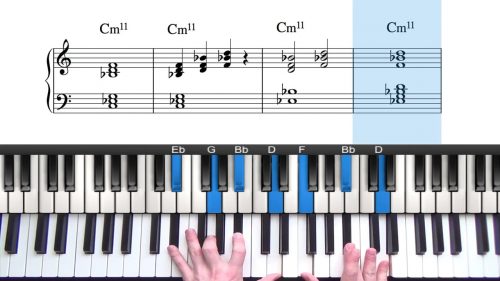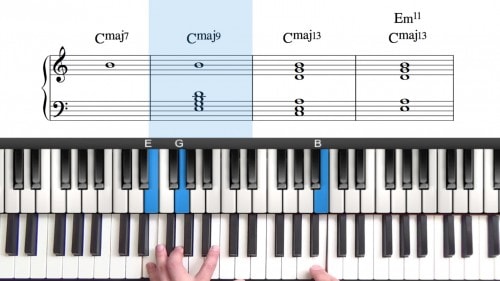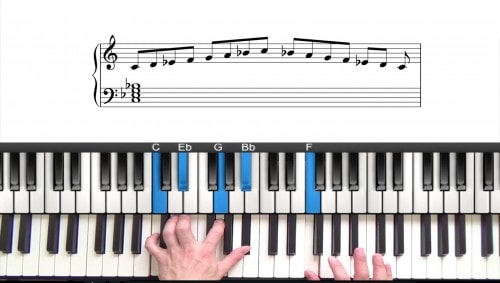Time Remembered Tutorial – Bill Evans
Time Remembered is unusual as is doesn’t contain any dominant 7th or half and diminished chords. This makes it a modal composition with interesting chord changes.
Bill uses unusual root movements and lots of colourful upper extensions in the melody to create rich and interesting melodic lines.
We are going to start the tune playing left hand voicings and then add some bigger two handed voicings similar to what I was playing in the intro. There are many new voicings covered in this lesson including some interesting polytonal #11 chords and lots of quartal-inspired voicings variations.
Practice Tips
-
There are some important voicings covered in this lesson - try to memorise the scale degrees so that you can apply them to other tunes.
-
We cover lots of major and minor upper structures becuase the tune does not contain any dominant chords.
-
You should now have a better understanding of the application of major and minor upper structures and how these can be applied to tunes.
-
Take away the concept of inverting the upper structure and experiment with your own voicings.







Can’t believe this marvelous lesson doesn’t have any comments! First of all the tune itself is unusual and fascinating, the voicings are exquisite – especially the arpeggiated Bm9 chords in the last line and the RH descending fourths in the previous one – and best of all, we’re calmly walked through the whole process in a way that’s easy to follow throughout and never tries to show off the way a lot of online jazz teachers seem to. My only technical problems were with the Kenny Barron voicings, which are generally too much of a stretch for me – but easier-to-reach alternatives are still covered. For the Herbie m9 voicings, both for ease of playing and sound I prefer the “modern” variation you use in a couple of places that moves the root up an octave, leaving the 5th on the bottom. Overall, it’s hard to see how a lesson on such a tricky piece could be improved.
Yes wonderful tune isn’t it Martin!…. it’s always been a favourite of mine. I love all of the upper extensions and alterations in the melody… it opens up many possibilities for voicings and upper structure triads.
Glad you like the teaching style… I try my best not to ‘get in the way’ of the lesson :-)
Always remember you can ‘roll’ wide voicings… this will naturally become part of your playing style… it may feel unnatural at first but stick with it.
Agreed. The Herbie Hancock variation with the 5th on the bottom is awesome, it also has some interesting voice leading possibilities into the 5 chord (just move every note of the triad in your right hand up a half step to access b9, #11 and b7) and play this over the shell (R & b7) in the left hand. This works in any key.
Really glad you enjoyed the lesson… also check out the Bill Evans version of this tune where he performed with a full orchestra:
Cheers,
Hayden
Re. the II-V-I using Herbie alt voicing for the m9: that V voicing is also interesting! The question then becomes how it would resolve to the I… A couple of ideas, using Gm9 – C7(b9#11b7) – Fmaj7 as example. For the Fmaj7 you could try C-F-A / D-G-B (i.e. F second inversion / G second inversion). This is really an Fmaj7#11/C bc of the top B. Other RH voicings: E-G-B (instead of D-G-B) or even C-E-G-B. I’m not sure about the #11 (here B): would there be a smoother voicing for the I chord?
Indeed all of those options would work fine. Voicing the #11 in the I chord takes the sound a little ‘out there’ – so this is down to taste more than anything else. I personally like the sound of resolving into a 6/9 voicing for the I chord. I’d recommend taking this progression around all 12 keys… I use it all the time! Cheers, Hayden
I’m a long way from nailing this tune Hayden, but from my perspective (early days etc) I’ve found it really useful from the perspective of beginning to wrap my head around upper structure triads and inverting the triad- e.g. the M7#11. US 2 on my cheat sheet or in other words built off the 9th. Or starting a whole step up from the Root. I’m not sure I understand the minor triad off the Major 7th of CM 7 #11 (BDGb or Bm), the second chord in? Apart from the fact it sounds good. What am I missing? Cheers mate.
Ignore that stupid question mate. I got 10 yards down the road on my walk and worked it out. Feel like a dill now. I’m just playing the M7, 9 and #11 as a minor triad. It’s been a long day! I’ve never studied the structure of music until now so bear with me. I am loving it though.
Hey Eric… glad you figured it out. To clarify, identifying upper structures within major and minor chords gives you formulas that you can then apply to any chord.
So for example, if you want to get a major 13 #11 sound, you know that you can build a major triad off the 9 – and this works in any key. So instead of having to think of the individual notes, you just thinking of a triad which simplifies the thought process to achieve rich extended and altered sounds.
A bit of a mouthful of an explanation but it’s important to understand. This is also the core premise behind dominant chord upper structures.
Cheers,
Hayden
Thanks Hayden, I found that explanation really useful. Before I fire off a question next time, I’ll spend more time trying to work it out myself. I think the positive aspect of this for me is that I’m finding it really interesting and getting a real kick out the theory and it’s application. I never thought I’d be doing this, but I am and I’m loving it. Cheers mate.
What a fantastic tutorial!!!I agree with Martin. What planet have I been on???
Hi Adam 👋🏻
Yes this is a great tune.
It’s fascinating how Bill Evans wrote the song without any dominant chords!
Cheers,
Hayden
Hi Hayden,
I loved the tutorial and the tune arrangement makes me sound like a pro (I think).
One question – What would be the recommended progressions to use in this tune for intro or ending?
What I do is basically throwing out chords from the lead sheet and play them with different voicing and adding small melody lines. But I feel like I am out of structure in this way..
Thanks.
Ariel.
Hi Ariel 👋🏻
Great question!
This tune doesn’t have any dominant chords and so an intro containing dominant chords such as a Imaj7 / VI7 / ii-7 / V7 may sound rather unusual. However, something to experiment with and make your own mind up.
Here’s some other ideas:
Taking the last measures of the tune is always a nice idea and use with the melody and harmony in the final bar to lead you into the start of the tune.
A vamp intro and/or outro could also be nice. Perhaps try vamping between B-9 to F#-9 back to B-9, to E-9, then back to B-9 etc…. so basically vamping with minor 9th chords which are a 5th apart. By switching between closed and open position our hand doesn’t need to move much and it creates a nice rich sound.
Also notice that Bill uses a lot of major#11 voicings, ie major chords with the #11 in the melody – bars, 3, 7, & 8 for example. It could be nice to hint at this in the intro.
Finally listening to recordings on YouTube or Spotify may yield some ideas and inspiration.
Hope this helps and have fun playing around with this.
Cheers,
Hayden
ps. The story is interesting behind this composition is interesting and maybe something worth looking into. It might also give you some additional ideas/inspiration. Before early classical music there was the modal system of harmony where musicians would compose using just major and minor scales.
I believe the story goes that Bill Evans called this composition “Time Remembered” for this reason, to remember that period of musical creativity. Of course modal music made a resurgence in jazz the 1960s, but this composition is somewhat unique in that there are no dominant chords and much of the interest is derived from the extensions and alteration Bill uses in the melody.
Fantastic lesson .
There is a docu on Bill Evans on Amazon Prime called Time Remembered.
Thanks, for this great tutorial, Hayden. Is there a transcription available?
Hi Rebecca,
Glad you enjoyed the tutorial.
I haven’t yet transcribed this arrangement but I can create one.
I do play the tune quite freely, similar to Bill Evans versions, and so it might be a little tricky to notate it perfectly accurately.
Leave it with me. Perhaps it would be best just transcribe the voicings and place them under the lead sheet to show how they work with the melody and chord changes.
Cheers,
Hayden
Hayden, how do you document your arrangements once you create them? Do you take the lead sheet and write the voicings on the lead sheet itself (I.e., “Kenny Barron, Upper Structure off 2nd, Rootless A, etc.) or do you play the arrangement into software like Musescore and print out the arrangement? Or do you just memorize? Some of your lessons include the arrangement along with the lead sheet, but others don’t.
Also check out the “Notating Lead Sheets” PDF Download that you can find in the seminar resources here: pianogroove.com/live-seminars/beginner-jazz-qa-session/
Cheers,
Hayden
Hi Kirk,
I answer that exact question in this seminar: pianogroove.com/live-seminars/beginner-jazz-qa-session/ – see chapter 6 “Creating Fills & Arranging Tunes”.
Usually I will notate the lead sheet but just with the chord colours or extensions used. That way I know what kind of sounds and tensions I like, but it does not constrain me to a specific voicing.
Part of this process is to teach the arrangements on PianoGroove and after playing the tunes for many years I naturally memorise parts of the arrangement but I always try to keep an open mind to find new ways to play the tune and new reharmonisations to add etc…
Some of the tunes I play in a free rubato style, and so it’s difficult to notate them. This is one of them. I can create a PDF with the voicings used if that would be useful.
Cheers,
Hayden